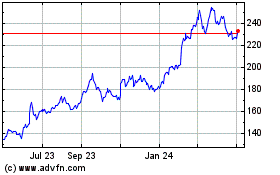China Car Sales Growth Slows Further
January 12 2016 - 4:10AM
Dow Jones News
SHANGHAI—China's car sales in 2015 reached a new high but growth
slowed further, as a cooling domestic economy took a toll on demand
in the world's largest auto market.
China sold 21.1 million passenger cars—sedans,
sport-utility-vehicles and minivans—last year, up 7.3% from a year
earlier, government-backed China Association of Automobile
Manufacturers said Tuesday. The growth was compared with a 10% rise
in 2014 and a 16% gain in 2013.
Growth could have been lower if the government had not lent a
hand. China's car sales fell into a recession in the summer as a
worse-than-expected economic downturn and plummeting stock prices
scared off buyers. However, Beijing's halving of the 10% purchase
tax on small-engine vehicles in October reinvigorated sales.
In December, China's car sales rose 18% from a year earlier,
said the industry group, following a 24% rise in November and a 13%
gain in October. Nearly 70% of China's new-car sales qualify for
the tax break.
Xie Wei, a dealer in the central Henan province for Chevrolet
and Hyundai, said he is cautious about this year even as foot
traffic has recovered after the tax break. "Demand from first-time
buyers is not strong as expected. I feel people are very worried
about their jobs and income," said Mr. Xie.
Despite a series of stimulus policies including successive
interest-rate cuts and a devaluation of the local currency, China's
economy is still heading to the lowest expansion rate in a quarter
of century.
"We are convinced the growth seen in recent months simply cannot
last," said Robin Zhu, a senior analyst at research firm Sanford C.
Bernstein. He cited a large buildup of inventory at dealerships in
recent months, saying that it might pull back wholesale delivery
growth.
A recent survey by the China Automobile Dealer Association of
more than 22,000 dealers showed that their average inventory level
was 1.4 months of sales in November, up from 1.3 months in October.
In China, analysts regard 1.5 as the "alert level" at which auto
dealers should begin to be concerned about high inventory.
Also, car prices, a key measure of demand, remain depressed.
According to a study by Ways Consulting, a Guangzhou-based
consulting firm focused on China's automotive industry, discounts
widened to 11.5% on average in the fourth quarter from 11% in the
previous quarter.
Major car makers reported slower growth for last year. General
Motors Co. posted a 5.2% rise in its China sales, down from 12% in
2014. Over the same period, Toyota Motor Corp.'s gain in China fell
to 8.7% from 12.5%, and Ford Motor Co.'s shrank to only 3% from
19%.
Foreign car makers have been the biggest beneficiaries of
China's economic boom. They built more plants in China than
anywhere else in the past decade, capitalizing on Chinese
consumers' taste for upscale products. Still, they had to cut
prices and curtail production in China in the middle of last year
when sales fell short of expectations.
Even though the tax break has reaccelerated growth, foreign
companies are circumspect when looking into the new year. GM and
Ford said they anticipated continued growth in 2016, without
providing a target. Toyota said it is aiming to sell just 2.7% more
cars in China this year compared with last year.
Chinese domestic car makers held a bright spot for 2015. Data
show that sales of Chinese domestic car brands rose 15% from a year
earlier to 8.7 million vehicles, beating the overall industry's
growth. The gains mostly came from their aggressive launches of
budget SUVs, said analysts.
Compared with foreign players, Chinese homegrown car makers are
more optimistic as their launch sprees will continue. Great Wall
Motor Co., a SUV maker, aims to sell 11% more cars this year
compared with the year-earlier period, and Geely Automobile
Holdings Ltd., whose parent owns Swedish brand Volvo Car, targets
an 18% year-over-year rise.
The auto-manufacturers' group projected China's passenger car
sales to grow 7.8% this year to 22.76 million vehicles, thanks to
the tax break which will expire at the end of December. It forecast
sales of total motor vehicles, including both passenger and
commercial vehicles, will rise to 26 million units from 24.6
million units last year.
--Rose Yu
(END) Dow Jones Newswires
January 12, 2016 03:55 ET (08:55 GMT)
Copyright (c) 2016 Dow Jones & Company, Inc.
Toyota Motor (NYSE:TM)
Historical Stock Chart
From Jun 2024 to Jul 2024

Toyota Motor (NYSE:TM)
Historical Stock Chart
From Jul 2023 to Jul 2024
